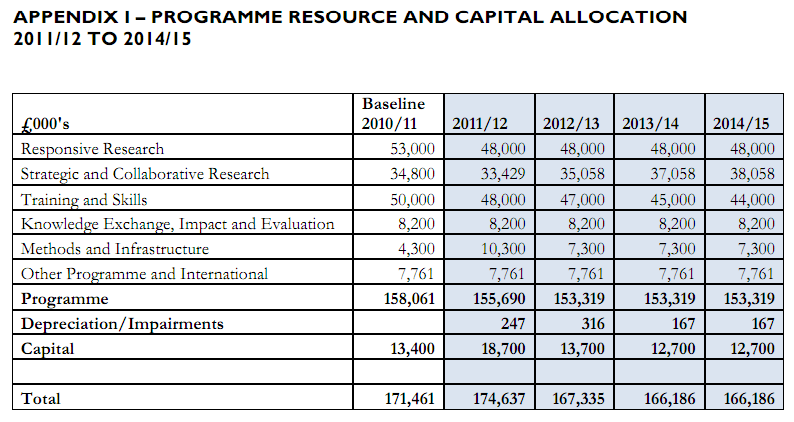 ESRC has recently published its Delivery Plan for 2011 – 2015 [PDF]. This document sets out the organisation’s strategic priorities for the next four years – i.e. the anticipated duration of the current Coalition government – and in particular outlines how they will respond to the austerity measures laid out in last October’s Comprehensive Spending Review. In some ways it is a change in focus rather than direction, but the implications of some of the changes are highly significant.
ESRC has recently published its Delivery Plan for 2011 – 2015 [PDF]. This document sets out the organisation’s strategic priorities for the next four years – i.e. the anticipated duration of the current Coalition government – and in particular outlines how they will respond to the austerity measures laid out in last October’s Comprehensive Spending Review. In some ways it is a change in focus rather than direction, but the implications of some of the changes are highly significant.
The key messages are:
- Further concentration of research funding: “We will continue to support the pursuit of excellence with a move to longer, larger awards and a further concentration of our funding of postgraduate training. We will continue to support the pursuit of excellence with a move to longer, larger awards and a further concentration of our funding of postgraduate training” (p4). We’ve heard this message before – larger grants for ESRC mean potentially greater impact, which is a critical part of this Plan (p18). For universities and academics this means spending more time preparing more substantial applications and working increasingly in collaboration with other researchers and institutions. It’s likely that only senior, successful academics will have the experience necessary to lead projects of this scale, so a more joined-up and strategic approach to bidding across the sector (as well as within individual institutions) is urgently required.
- Focusing funding on three strategic priorities: Economic performance and sustainable growth; Influencing behaviour and informing interventions; A vibrant and fair society (p5-7). There will obviously be more emphasis on these priorities within ESRC’s strategic calls for funding, while responsive mode will “remain open to applications from across the social sciences” (p8). Tellingly, however, they also say: “we anticipate that fields important for our three focused priorities will receive significant support in responsive mode” (p8). More information on the three priorities is available in the Plan, and this will be further refined in Spring 2011 with “a set of specific multidisciplinary questions that will shape our research investments” (p5), so anyone interested in securing ESRC funding in future will need to study these carefully when they are released.
- Streamlining funding schemes on offer: “We will reduce the number of schemes we offer and focus the remaining schemes to ensure that the ESRC achieves more value” (p8). In practical terms, this means the Small Grants and Mid-Career Fellowships schemes are being axed. First Grants and Postdoctoral Fellowships are being discontinued as separate programmes and merged into a new “Future Research Leaders” scheme. ESRC anticipate this will fund 50-80 new grants per year, in comparison to an expected 25 for First Grants and 90 Postdoctoral Fellowships in the last round. For the Standard Grant scheme, the minimum funding threshold is to be raised to £200K Full Economic Cost in line with their stated aim to concentrate funding towards longer and larger grants (above).
- Concentration of doctoral research training through Training Centres: “Few institutions have strength in all social science fields so this new concentrated network of Doctoral training Centres focuses our resources by drawing together the best social science training” (p9). Again, concentration of funding is the watchword: ESRC will discontinue separate studentship competitions – it’s not clear if they also mean CASE studentships; focus funding for studentships on their key strategic priorities; and reduce the overall number of studentships they support from 750 to 600. There’s also a significant focus on training in quantitative methods – numbers of these postgraduates will be doubled and they will be eligible for enhanced stipends (p10).
- Increase partnership working, both nationally and internationally: This point covers the knowledge exchange work supported by ESRC as well as their approach to supporting research in collaboration with international partners. They aim to raise the proportion of private sector co-funding (p13) and work to rationalise their targeted international schemes to “include international perspectives in all ESRC and cross-Council activities from an early stage” (p14). The ESRC’s Open Research Area scheme already supports collaborations with Germany, France and the Netherlands, but here they specifically encourage work with Brazil, China, India, South Africa and North America.
Appendix 1 (p21) shows the resource allocation to the various ESRC funding schemes and this gives a relatively clear picture of their priorities. Most streams receive a cut in funding from 2011/12 (when compared to the 2010/11 baseline), but the Strategic strand builds back up at 4-6% per year thereafter whereas Responsive Mode stays frozen at £48M for the duration of the Plan (click to see full size):
In light of these cuts and the increasing concentration of research funding, AHRC, ESRC and the British Academy have released a joint statement [PDF] on support for early and mid-career researchers.


Pingback: ESRC Considers Demand Management Options « University Research Office Blog
Pingback: ESRC Future Research Leaders Scheme Opened « University Research Office Blog
Pingback: British Academy: Mid-Career Fellowship Scheme « Research Support Blog